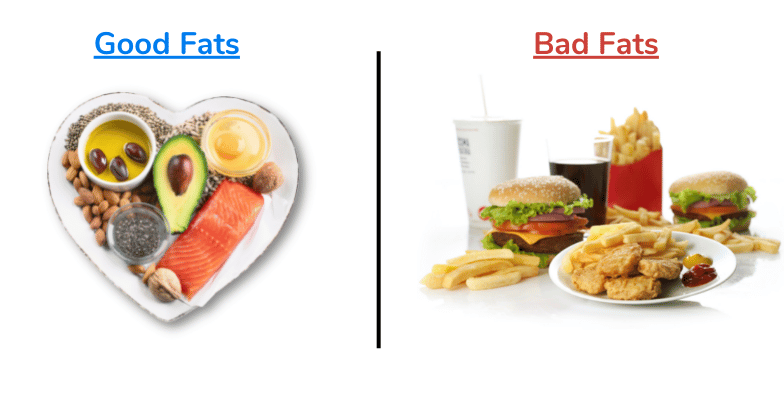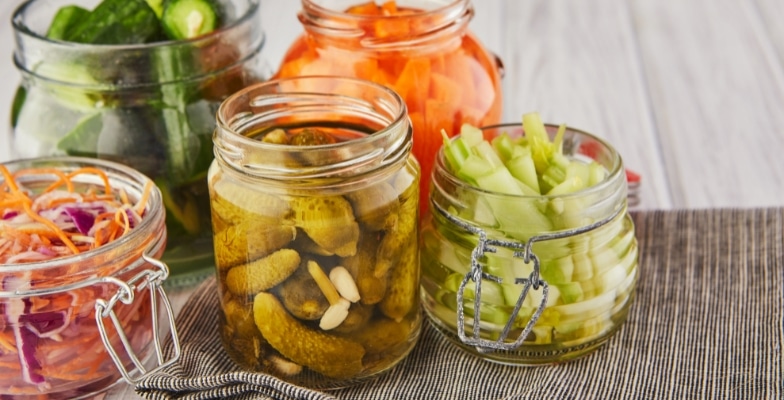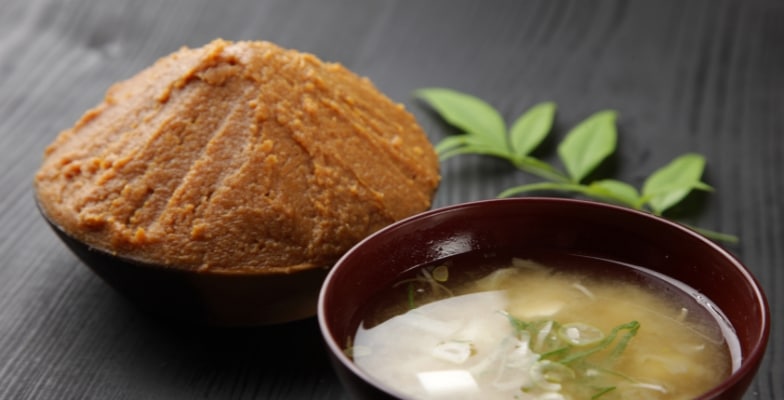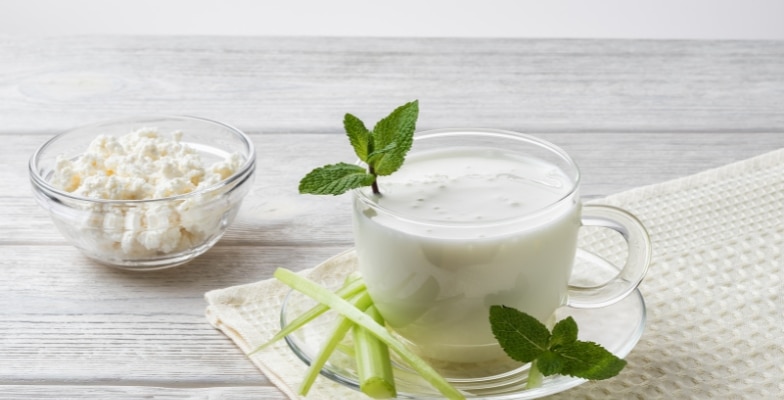Good Fat Vs. Bad Fat | Complete List & Chart
- What Is Fat?
- Composition Of Common Fats And Oils
- Which Fats Are Good And Which Are Bad?
- How Many Calories Should I Consume From Good Fats?
- Conclusion

When most people hear the word ‘fat,’ they tend to associate it with the adipose tissue in their bodies.
This isn’t the only misconception about dietary fat. Many think vegetable oils are healthy because they have the word ‘vegetable’ in their name.
Fat can be your best friend or your worst enemy. It is easy to get confused when talking about fats because some are good and some are bad. Let’s discuss this topic in more detail!
What Is Fat?
Fats are made of collections of molecules called triglycerides. If this collection is liquid at room temperature, it can be called an oil. If it’s solid, it is referred to as fat.
A triglyceride is formed from three fatty acids attached to a glycerol molecule.
Types Of Fat
Saturated Fat
Saturated fats are triglycerides that contain only single covalent bonds between fatty acid carbon atoms. Because they lack double bonds, each carbon atom is saturated with hydrogen atoms.
A few examples are butter, ghee, palm oil, coconut oil, and red meat.
Related Article: Saturated Fat | Good Or Bad?
Not all saturated fatty acids are the same. Their length is what sets the various types apart.
The shorter ones, which have a chain length of 3-6 carbons, are known as short-chain saturated fatty acids. An example is butyric acid, most commonly found in ghee.
Medium-Chain Saturated Fatty Acids
They are found in several different foods. Medium-chain triglyceride (MCT) oils are used in special medical formulas for people who need energy from fat but cannot absorb the longer-chain fatty acids.
The complete set of medium-chain fatty acids is especially important in infant formulas to duplicate the medium-chain saturated fatty acids found in human breast milk, especially the 12-carbon saturated fatty acid known as lauric acid, which functions as a special antimicrobial (antiviral, antibacterial, and antiprotozoal) fatty acid in human milk.
Some good examples of medium-chain saturated fatty acids are coconut oil and palm kernel oil. These short- and medium-chain saturated fatty acids are not deposited to any extent in the adipose tissue.
Long-Chain Saturated Fatty Acids
The long-chain saturated fatty acids range from 14-18 carbons. Palmitic acid, with 16 carbons, and stearic acid, with 18 carbons, are the most common saturated fatty acids found in food. The very long-chain saturated fatty acids (ranging from 20-24 carbons) are membrane fatty acids, which can be found in the brain.
Unsaturated Fat
Unsaturated Fats are divided into two main categories.
Monounsaturated fats and polyunsaturated fats.
Monounsaturated Fats
They contain fatty acids with one double covalent bond between two fatty acid carbon atoms. They are not completely saturated with hydrogen atoms.
This type of fat can be found in carbon lengths of 14, 16, 18, 20, 22, and 24. The 18-carbon monounsaturated oleic acid is by far the most common variant. The best-known source of oleic acid is olive oil.
Polyunsaturated Fats
These contain more than one double covalent bond between fatty acid carbon atoms. Polyunsaturated fatty acids are found in lengths of 18, 20, and 22 carbons.
The best-known fats in this category are omega-6 fatty acids (linoleic, gamma-linolenic, and arachidonic acids) and omega-3 fatty acids (alpha-linolenic, eicosapentaenoic [EPA], and docosahexaenoic [DHA] acids).
Related Article: Unsaturated Fats | Good Or Bad?
All fats and oils, regardless of whether they are of vegetable or animal origin, are some combination of saturated fatty acids, monounsaturated fatty acids, polyunsaturated linoleic acid and linolenic acid.
In general, animal fats such as butter, lard, and tallow contain about 40-70 percent saturated fat and are solid at room temperature.
Composition Of Common Fats And Oils
Please note the composition of these oils are rough estimates and may vary from brand to brand and how the oil has been processed.
Olive Oil
I like to pour olive oil over my salads and pasta.
You should opt for extra-virgin olive oil, where the best ones are cloudy, which indicates that they have not been filtered and have a golden yellow color.
It’s ok to use extra-virgin olive oil for light cooking, like when making eggs. Otherwise, for main cooking purposes, oils high in saturated fats like ghee or coconut oil should suffice.
73% MUFA
11% Omega-6 PUFA
2% Omega-3 PUFA
14% SFA
Related Article: Olive Oil Health Benefits | Five Methods To Ensure You Buy The Highest Quality Olive Oil
Canola Oil
Canola oil is developed from rapeseed, a member of the mustard family.
The characteristic rapeseed oil contains high levels (40 to 50 percent) of very long-chain monounsaturated fatty acids, such as erucic acid, which is currently considered nutritionally undesirable for the average human.
Because rapeseed is very adaptable to genetic manipulation, plant breeders have been able to develop varieties of rapeseed that have a high level of oleic acid instead of erucic acid. This variety of rapeseed oil is what we call canola oil.
57% MUFA
23% Omega-6 PUFA
10-15% Omega-3 PUFA
5% SFA
Related Article: Is Canola Oil Good For Health?
Peanut Oil
Peanut oil is healthier than corn or sunflower oil because of its relatively high content of MUFAs, but it is prone to rancidity when compared to lard or ghee. It is also known as groundnut oil.
45% MUFA
32% PUFA
18% SFA
Related Article: Is Groundnut Oil Good For Health?
Coconut Oil
Coconut oil comes from the fruit and seed of the coconut palm tree, which is grown in all parts of the tropics and subtropics.
Coconut oil is very stable and does not become rancid when cooked at high temperatures. In addition, coconut oil is a major source of lauric acid. Lauric acid has antimicrobial properties and is also used extensively in infant formulas.
This fatty acid is found in human breast milk, which plays a critical role in infant nutrition.
6% MUFA
1.5% PUFA
93.5% SFA
Related Article: Coconut Oil Good Or Bad?
Ghee (Clarified Butter)
Ghee is one of the oldest fats from animal sources. In the United States, ghee comes predominantly from cow’s milk, whereas in India, it can also come from buffalo, goat, or sheep milk. As a result, ghee is a staple in Indian cooking.
29% MUFA
5% PUFA
66% SFA
Related Article: Is Ghee Good For Health?
Lard
Lard is rendered fat that comes from pigs. Lard has been a popular fat for centuries in many parts of the world, including China, parts of Europe, and until recently, the United States. Lard is popularly used for making pastries and frying potato chips.
50% MUFA
10% PUFA
40% SFA
Tallow
Tallow is rendered fat from cattle, sheep, or lamb. Tallow has also been in use for centuries. This stable fat does not become rancid; no free radicals are formed from normal usage. In addition, tallow contains an antimicrobial fatty acid, palmitoleic acid.
40% MUFA
3-6% PUFA
50-55% SFA
Finally, there are oils that are particularly high in Omega-6 PUFA. Most of these oils are highly processed before reaching supermarket shelves.
Moreover, they are very unstable at high temperatures and should not be used for cooking or frying. These oils include sunflower, soybean, and corn oils.
Which Fats Are Good And Which Are Bad?
Good Fats
Saturated Fats
Saturated fats have gotten a lot of attention in the press over the years, but these fats have been unfairly demonized.
It all started with Ancel Keys’ and the Seven Countries Study. 1https://www.sevencountriesstudy.com/about-the-study/investigators/ancel-keys/ Keys launched the Seven Countries Study in 1958 to research the relationship between dietary patterns and the prevalence of coronary heart disease. He uncovered a direct link between heart disease from high total serum cholesterol and saturated fat intake.
However, the study was seriously flawed. Keys started out with data from 22 countries and simply omitted the data from the countries that didn’t fit with his hypothesis!
For the last four decades, because of him and his deceptive study, we have been eating cereals with skim milk instead of whole egg omelets made in butter.
In 2010, a meta-analysis involving more than 300,000 individuals found no significant evidence that dietary saturated fat is associated with an increased risk of coronary heart disease or cardiovascular disease. 2https://www.ncbi.nlm.nih.gov/pmc/articles/PMC2824152/
A recent article in the British Medical Journal by British cardiologist Aseem Malhotra, an interventional cardiology specialist registrar at Croydon University Hospital in London, states,
The mantra that saturated fat must be removed to reduce the risk of cardiovascular disease has dominated dietary advice and guidelines for almost four decades.
Yet scientific evidence shows that this advice has, paradoxically, increased our cardiovascular risks.
The aspect of dietary saturated fat that is believed to have the greatest influence on cardiovascular risk is elevated concentrations of low-density lipoprotein (LDL) cholesterol.
Yet the reduction in LDL cholesterol from reducing saturated fat intake seems to be specific to large, buoyant (type A) LDL particles, when in fact it is the small, dense (type B) particles (responsive to carbohydrate intake) that are implicated in cardiovascular disease.
Indeed, recent prospective cohort studies have not supported any significant association between saturated fat intake and cardiovascular risk. Instead, saturated fat has been found to be protective.
A meta-analysis of observational studies and 27 randomized, controlled trials published in the Annals of Internal Medicine also concluded that current evidence does not clearly support cardiovascular guidelines that encourage high consumption of polyunsaturated fatty acids and low consumption of total saturated fats.
This particular analysis included data from more than 600,000 people in 18 countries. 3https://www.acpjournals.org/doi/10.7326/M13-1788?articleid=1846638&
Polyunsaturated Fats
Omega-3
The University of Maryland Medical Center states that omega-3 fatty acids reduce inflammation and might help lower the risk of chronic diseases such as heart disease, cancer, and arthritis.
Omega-3 fatty acids are highly concentrated in the brain and appear important for cognitive and behavioral functions, such as brain performance and memory.
In fact, infants who do not get enough omega-3 fatty acids from their mothers during pregnancy are at risk of developing vision and nerve problems.
Omega-3 fatty acid deficiency symptoms include fatigue, poor memory, dry skin, heart problems, mood swings, depression, and poor circulation.
Your body cannot make these fatty acids, which is why they are called ‘essential.’ Therefore, we must obtain our essential fatty acids, or EFAs, from our food.
Related Article: Omega 3 Fatty Acids Benefits And Daily Requirement
Bad Fats
Polyunsaturated Fats
Omega-6
Even though Omega-6 polyunsaturated fats are essential to us, when eaten in excess, they may pose health issues.
Anthropology studies indicate that humans evolved on a diet with a ratio of omega-6 and omega-3 essential fatty acids of approximately 1!
But unfortunately, the western diet’s ratio is highly skewed, i.e., 15/1 – 16.7/1. Many experts believe that this is a severe health problem. 4https://www.ncbi.nlm.nih.gov/pubmed/12442909
For optimal health, a ratio of omega-6 and omega-3 of [1-4]/1 should suffice! The ratio in today’s western diet is skewed because of the soaring popularity of vegetable oils in the past century.
Bottom line
It is a very good idea to limit your intake of omega-6 by completely replacing cooking in vegetable oils with ghee and/or coconut oil. It also makes a lot of sense to increase your intake of omega-3 fatty acids.
Trans Fats
Trans fats are created when polyunsaturated vegetable oils are heated in the presence of hydrogen gas in order to make them solidify.
Trans fats are used abundantly in processed foods because they improve taste, increase shelf life, and have a less greasy feel. The American Heart Association advises that people avoid consuming products that contain this type of fat.
Trans fats are known to increase blood levels of low-density lipoprotein (LDL), or bad cholesterol, while lowering levels of high-density lipoprotein (HDL), or good cholesterol. Trans fats have also been linked to an increased risk of heart disease and diabetes.5https://www.ahajournals.org/doi/full/10.1161/circulationaha.106.679985
Dr. Mary G. Enig, an expert in lipid biochemistry, determined that ingesting trans fats alters the activities of the enzyme system, making it easier to get cancer and harder for prescription drugs to fight it.
How Many Calories Should I Consume From Good Fats?
I hope I have shown you exactly why you should not fear good fats. Armed with the knowledge of which fats are good and which are dangerous, you can approach this macronutrient in the healthiest way possible.
-This means consuming at least 30% of calories from good fats for optimal health and a host of other important functions, like the fact that healthy fats are needed for the absorption of fat-soluble vitamins, such as vitamins A, D, E, and K.
-Also, keep in mind that fat is digested slowly. This has a magical effect on weight loss because it curbs hunger pangs that tend to lead to overeating carbohydrates, especially the dangerous refined variety.
-Do not fear whole milk and whole eggs. Embrace them, and eat them as nature intended.
-Do not fear saturated fats. They are your best friends and should be responsible for most of the calories you eat from fat.
-Avoid trans fats at all costs. They are the worst kinds of fat and wreak havoc on your body.
-Be sure to include sources of EFA omega-3, as the body cannot manufacture it. Some good sources include fatty wild-caught fish, flaxseed, and krill oil supplements.
-You should absolutely limit your intake of omega-6 polyunsaturated fatty acids (PUFAS) from the majority of vegetable oils.
-This will improve your ratio of omega-3 to omega-6 fats. Ideally, you should limit the consumption of omega-6 fats (sunflower oil, cottonseed oil, etc.) to just 2-3% of your daily calories.
-Make a point of including some lauric acid in your diet because it has superior health properties. Lauric acid can be found in coconut, coconut oil and other coconut products.
Conclusion
I realize that this article might come across as being quite radical for many of you. I know it was a lot for me to wrap my mind around when I first read this information several years ago.
However, I had faith in honest voices such as Dr. Mary Enig, Sally Fandon (president of the Weston Price Foundation), and Dr. Mercola (the founder of www.mercola.com).
I also had faith in what my parents used to eat. I grew up in Haryana, India, where the diet typically consists mainly of whole milk and ghee. Sometimes when I visit my village, I marvel at how the people there are glowing with radiant health (they are mostly unaffected by the multi-billion dollar food processing industry).
This leads me to ponder an important question: Should I trust nature to give us healthy food, or should I trust man’s claims that these natural foods can be improved?
I think I will go with nature. 🙂
What do you think about dietary fats? Have any questions? Let me know in the comments below!

Skill-Based Education.
Global Recognition.
Powerful Community Building
Secure a certificate of completion in as little as a day by graduating from one of our free courses.
Get Access to Our Free Courses. No Credit Card Required.

Fabulous Body Membership
Your All-Access Pass to A Fabulous Body & A Rewarding Career
25+ Certificate Courses & Programs, All Included
15 Day Free Trial, 100% Money-Back Guarantee
About Akash Sehrawat
Akash is a creator of 25+ programs and certificate courses in which more than 200,000 students have enrolled both on Udemy and Fabulous Body's native platform. Akash is also an author of three books that can be found on Amazon. His answers on Quora have gathered more than 12 million views in less than a year.











Hey, there are many.
Fat foods: Milk fat, egg fat, walnuts, almonds, coconut oil, extra virgin olive oil, desi ghee etc.
Protein food: All diary products ( yogurt, paneer), eggs, dal, rajma, chole. read this post to know more:https://fabulousbody.com/the-ultimate-guide-to-consume-upto-100gms-of-protein-if-you-are-a-vegetarian-or-a-vegan-2/
can you throw some light on rice bran oil , mustard oil n all. these are in trends in india.
Hi Latika,
We already have an article on mustard oil and its benefits. Please click on this link Is Mustard Oil Good For Health?
For information on more oils, including those popular in India, we have a dedicated video available Best Cooking Oil for Health | 11 Cooking Oils from BEST to WORST
If you have any further questions, please feel free to ask.
Regards,
Kunal,
Team Fabulous Body